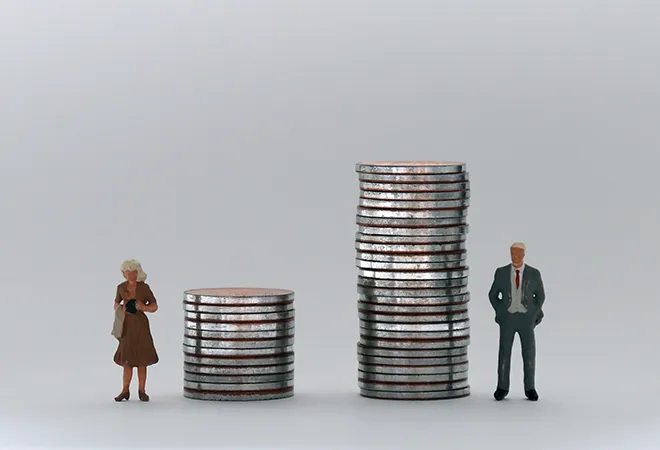 This article is part of the series — Catalysing Change: Women-led Development in the Decade of Action.
This article is part of the series — Catalysing Change: Women-led Development in the Decade of Action.
If COVID-19 was a monumental challenge for the world at large, for women across the world, it has come to present a sharp fall off a cliff. The road ahead looks uncertain and disquieting. The pandemic took not just lives, but livelihoods as well. Unemployment numbers have surged worldwide. In total, there was unprecedented global unemployment losses of 114 million jobs in 2020 relative to 2019.
Furthermore, in relation to 2019, employment losses were higher for women (5 percent) than for men. Predictably, it’s hit women the hardest. The International Labour Organisation (ILO) notes that in nearly all G20 economies for which recent data is available, there was an increase in the labour force participation rate of women aged 15-64 between 2012 and 2019. India was the only exception where there was a fall in the labour force participation of women. This is backed by local numbers as well. The Centre for Monitoring Indian Economy (CMIE) notes that women accounted for 10.7 percent of the workforce in 2019-20 but they suffered 13.9 percent of the job losses in April 2020 (the first month of the lockdown shock). By November 2020, men recovered most of their lost jobs but women were less fortunate. A staggering 49 percent of the job losses by November 2020 were women’s.
In relation to 2019, employment losses were higher for women (5 percent) than for men.
Crises of all kinds disproportionately impact women; COVID-19 created a health emergency and also wreaked havoc on economies. History shows that in the aftermath of these economic tornadoes, women tend to earn less. They also have fewer savings and often less access to social protections. Ironically, those that managed to hold on to employment were burdened with unpaid care and domestic work; therefore, forcing them to drop out of the labour force. Add to that, a skewed social structure that works at gating women out of the workforce right from the start. The Economist captures the reality as it notes, “Whereas women in other countries often withdraw from the workforce when burdened with a child, women in India drop out when burdened with a husband.”
But why does work, of any form and structure, matter so much in the lives of women? It is primarily because employment brings with it financial independence, and financial independence means an equal voice — a voice that can be heard at home, in a community, and in a nation. Research conducted by Rohini Pande, professor of public policy at Harvard Kennedy School, shows that women who received wages in their own bank accounts worked more and saved more. Having used a bank account changed their sense of self, notes Pande, adding that they began describing their occupation as “worker” instead of “housewife.” That’s just the first step. Women who earn for themselves are also more likely to spend that money towards better healthcare, education, and living standards for their families. Girls and women spend 90 percent of their earned income on their families.
Women who earn for themselves are also more likely to spend that money towards better healthcare, education, and living standards for their families.
This begs the question, particularly in the pandemic world 2021: Are we doing enough to encourage women to save their hard earned money, in a way that helps them and also addresses their unique needs? A nationwide survey, conducted by IndiaFirst Life Insurance covering over 5,000 low-income women, found that a majority of them (75 percent) in the age group of 26-41 years were seen putting their money in savings bank accounts while only 12 percent were found to be opting for life insurance policies. The women said they preferred bank accounts because they wanted to withdraw their savings whenever they needed the money. Neither was there enough information about insurance nor any clarity on the difference between life, general or health insurance and the ultimate benefits.
Is the financial world even thinking of women while structuring or creating investment products? Does the industry seek to support women and educate them, especially those women from the lower-income bracket on the options that are available to them, and why one financial instrument may be better than the other?
Why are women hesitant to invest? A part of the answer lies in a complex socio-cultural web where women are discouraged from participating in discussions or decisions around investing.
Let’s flip that same question — Why are women hesitant to invest? A part of the answer lies in a complex socio-cultural web where women are discouraged from participating in discussions or decisions around investing. Money matters are often portrayed as a “male domain” and women are neither consulted nor involved while financial decisions are taken for a household or a joint family structure.
Secondly, there’s also the lack of relevant advice. Many women find financial advisors rigid in their opinion and unempathetic to the individual needs or aspirations of women. They find themselves bombarded with financial jargon about various instruments. Added to that is the judgemental tone, many women confide, they face. As a single parent, a housemaker or someone who’s married and employed, the financial needs and aspirations of women vary greatly — something many financial advisors tend to miss completely. There should not be a one-size-fits-all approach towards women and their investing choices, and clubbing them that way is an ill-advised move.
Finally, the hard truth — Women across the world have much less to spend and even lesser to save.
The World Economic Forum’s Global Gender Gap Report 2020 says men and women will only have pay equality in 257 years! Of the 153 countries studied for the report, India ranks 112th on the overall Global Gender Gap Index. For many women, especially from lower-income jobs and the informal sector, saving is a luxury they just cannot afford.
As a single parent, a housemaker or someone who’s married and employed, the financial needs and aspirations of women vary greatly — something many financial advisors tend to miss completely.
Since the start of the pandemic, in Europe and Central Asia, 25 percent of self-employed women have lost their jobs, compared to 21 percent of men — a trend that is expected to continue as unemployment rises. Projections from the ILO suggest the equivalent of 140 million full-time jobs may be lost due to COVID-19, and women’s employment is 19 percent more at risk than men. Women are over-represented in many of the industries hardest hit by COVID-19, such as food service, retail, and entertainment. For example, 40 percent of all employed women — 510 million women globally — work in hard-hit sectors, compared to 36.6 percent of employed men.
These numbers may read as a rush of statistics, like many others we have scoured through in 2020 and the months between. But they represent lives and families that have been ruptured, in some cases irretrievably. Even as this Women’s Day heralds its theme of ‘Choose to Challenge,’ the writing on the wall is clear. COVID-19 has meant many steps back for the financial independence of women. And the onus of ensuring that they find their voice again is on every institution and community capable of helping.
The views expressed above belong to the author(s). ORF research and analyses now available on Telegram! Click here to access our curated content — blogs, longforms and interviews.



 This article is part of the series —
This article is part of the series —  PREV
PREV


